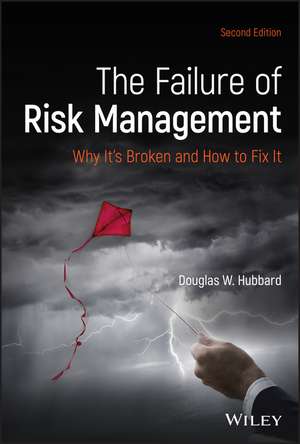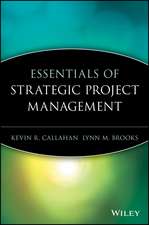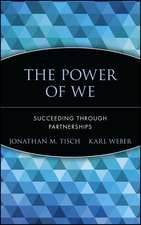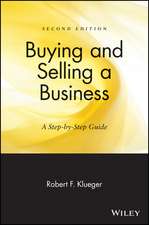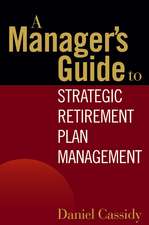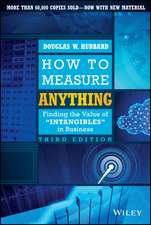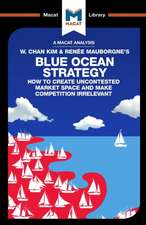The Failure of Risk Management – Why It′s Broken and How to Fix It, Second Edition
Autor DW Hubbarden Limba Engleză Hardback – 22 mar 2020
Preț: 266.39 lei
Nou
Puncte Express: 400
Preț estimativ în valută:
50.98€ • 53.03$ • 42.09£
50.98€ • 53.03$ • 42.09£
Carte disponibilă
Livrare economică 22 martie-05 aprilie
Livrare express 11-15 martie pentru 41.16 lei
Preluare comenzi: 021 569.72.76
Specificații
ISBN-13: 9781119522034
ISBN-10: 111952203X
Pagini: 384
Dimensiuni: 163 x 237 x 34 mm
Greutate: 0.59 kg
Ediția:2nd Edition
Editura: Wiley
Locul publicării:Hoboken, United States
ISBN-10: 111952203X
Pagini: 384
Dimensiuni: 163 x 237 x 34 mm
Greutate: 0.59 kg
Ediția:2nd Edition
Editura: Wiley
Locul publicării:Hoboken, United States
Cuprins
About the Author xi Preface xiii Acknowledgments xvii Part One An Introduction To The Crisis 1 Chapter 1 Healthy Skepticism for Risk Management 3 A "Common Mode Failure" 5 Key Definitions: Risk Management and Some Related Terms 8 What Failure Means 14 Scope and Objectives of This Book 17 Chapter 2 A Summary of the Current State of Risk Management 21 A Short and Entirely-Too-Superficial History of Risk 21 Current State of Risk Management in the Organization 25 Current Risks and How They are Assessed 26 Chapter 3 How Do We Know What Works? 35 Anecdote: The Risk of Outsourcing Drug Manufacturing 36 Why It's Hard to Know What Works 40 An Assessment of Self-Assessments 44 Potential Objective Evaluations of Risk Management 48 What We May Find 57 Chapter 4 Getting Started: A Simple Straw Man Quantitative Model 61 A Simple One-for-One Substitution 63 The Expert as the Instrument 64 A Quick Overview of "Uncertainty Math" 67 Establishing Risk Tolerance 72 Supporting the Decision: A Return on Mitigation 73 Making the Straw Man Better 75 Part Two Why It's Broken 79 Chapter 5 The "Four Horsemen" of Risk Management: Some (Mostly) Sincere Attempts to Prevent an Apocalypse 81 Actuaries 83 War Quants: How World War II Changed Risk Analysis Forever 86 Economists 90 Management Consulting: How a Power Tie and a Good Pitch Changed Risk Management 96 Comparing the Horsemen 103 Major Risk Management Problems to Be Addressed 105 Chapter 6 An Ivory Tower of Babel: Fixing the Confusion about Risk 109 The Frank Knight Definition 111 Knight's Influence in Finance and Project Management 114 A Construction Engineering Definition 118 Risk as Expected Loss 119 Defining Risk Tolerance 121 Defining Probability 128 Enriching the Lexicon 131 Chapter 7 The Limits of Expert Knowledge: Why We Don't Know What We Think We Know about Uncertainty 135 The Right Stuff: How a Group of Psychologists Might Save Risk Analysis 137 Mental Math: Why We Shouldn't Trust the Numbers in Our Heads 139 "Catastrophic" Overconfidence 142 The Mind of "Aces": Possible Causes and Consequences of Overconfidence 150 Inconsistencies and Artifacts: What Shouldn't Matter Does 155 Answers to Calibration Tests 160 Chapter 8 Worse Than Useless: The Most Popular Risk Assessment Method and Why It Doesn't Work 163 A Few Examples of Scores and Matrices 164 Does That Come in "Medium"?: Why Ambiguity Does Not Offset Uncertainty 170 Unintended Effects of Scales: What You Don't Know Can Hurt You 173 Different but Similar-Sounding Methods and Similar but Different-Sounding Methods 183 Chapter 9 Bears, Swans and Other Obstacles to Improved Risk Management 193 Algorithm Aversion and a Key Fallacy 194 Algorithms versus Experts: Generalizing the Findings 198 A Note about Black Swans 203 Major Mathematical Misconceptions 209 We're Special: The Belief That Risk Analysis Might Work, but Not Here 217 Chapter 10 Where Even the Quants Go Wrong: Common and Fundamental Errors in Quantitative Models 223 A Survey of Analysts Using Monte Carlos 224 The Risk Paradox 228 Financial Models and the Shape of Disaster: Why Normal Isn't So Normal 236 Following Your Inner Cow: The Problem with Correlations 243 The Measurement Inversion 248 Is Monte Carlo Too Complicated? 250 Part Three How to Fix It 255 Chapter 11 Starting with What Works 257 Speak the Language 259 Getting Your Probabilities Calibrated 266 Using Data for Initial Benchmarks 272 Checking the Substitution 280 Simple Risk Management 285 Chapter 12 Improving the Model 293 Empirical Inputs 294 Adding Detail to the Model 305 Advanced Methods for Improving Expert's Subjective Estimates 312 Other Monte Carlo Tools 315 Self-Examinations for Modelers 317 Chapter 13 The Risk Community: Intra- and Extra-organizational Issues of Risk Management 323 Getting Organized 324 Managing the Model 327 Incentives for a Calibrated Culture 331 Extraorganizational Issues: Solutions beyond Your Office Building 337 Practical Observations from Trustmark 339 Final Thoughts on Quantitative Models and Better Decisions 341 Additional Calibration Tests and Answers 345 Index 357
Notă biografică
DOUGLAS W. HUBBARD is the inventor of Applied Information Economics (AIE). His methodology has earned him critical praise from Gartner and Forrester Research. He is also the author of How to Measure Anything: Finding the Value of Intangibles in Business and How to Measure Anything in Cybersecurity Risk. His articles appear in Nature, The American Statistician, The IBM Journal of R&D, InformationWeek and many more. He has over 30 years of experience in management consulting focusing on the application of quantitative methods in decision making
